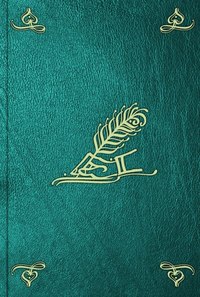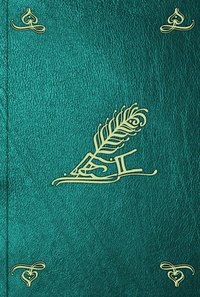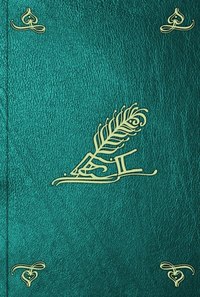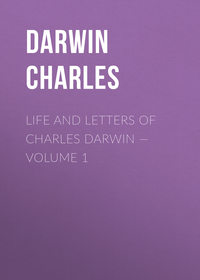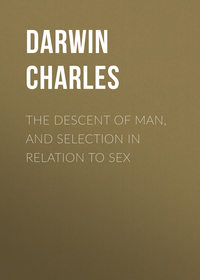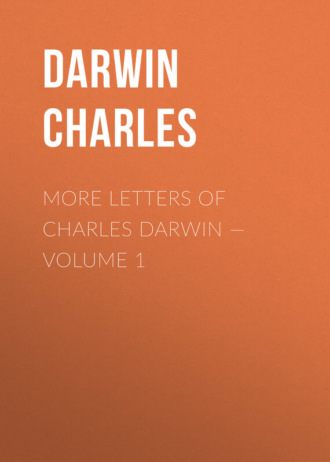 полная версия
полная версияMore Letters of Charles Darwin — Volume 1
LETTER 265. TO T. MEEHAN. Down, October 9th, 1874.
I am glad that you are attending to the colours of dioecious flowers; but it is well to remember that their colours may be as unimportant to them as those of a gall, or, indeed, as the colour of an amethyst or ruby is to these gems. Some thirty years ago I began to investigate the little purple flowers in the centre of the umbels of the carrot. I suppose my memory is wrong, but it tells me that these flowers are female, and I think that I once got a seed from one of them; but my memory may be quite wrong. I hope that you will continue your interesting researches.
LETTER 266. TO G. JAGER. Down, February 3rd, 1875.
I received this morning a copy of your work "Contra Wigand," either from yourself or from your publisher, and I am greatly obliged for it. (266/1. Jager's "In Sachen Darwins insbesondere contra Wigand" (Stuttgart, 1874) is directed against A. Wigand's "Der Darwinismus und die Naturforschung Newtons und Cuviers" (Brunswick, 1874).) I had, however, before bought a copy, and have sent the new one to our best library, that of the Royal Society. As I am a very poor german scholar, I have as yet read only about forty pages; but these have interested me in the highest degree. Your remarks on fixed and variable species deserve the greatest attention; but I am not at present quite convinced that there are such independent of the conditions to which they are subjected. I think you have done great service to the principle of evolution, which we both support, by publishing this work. I am the more glad to read it as I had not time to read Wigand's great and tedious volume.
LETTER 267. TO CHAUNCEY WRIGHT. Down, March 13th, 1875.
I write to-day so that there shall be no delay this time in thanking you for your interesting and long letter received this morning. I am sure that you will excuse brevity when I tell you that I am half-killing myself in trying to get a book ready for the press. (267/1. The MS. of "Insectivorous Plants" was got ready for press in March, 1875. Darwin seems to have been more than usually oppressed by the work.) I quite agree with what you say about advantages of various degrees of importance being co-selected (267/2. Mr. Chauncey Wright wrote (February 24th, 1875): "The inquiry as to which of several real uses is the one through which Natural Selection has acted...has for several years seemed to me a somewhat less important question than it seemed formerly, and still appears to most thinkers on the subject...The uses of the rattling of the rattlesnake as a protection by warning its enemies and as a sexual call are not rival uses; neither are the high-reaching and the far-seeing uses of the giraffe's neck 'rivals.'"), and aided by the effects of use, etc. The subject seems to me well worth further development. I do not think I have anywhere noticed the use of the eyebrows, but have long known that they protected the eyes from sweat. During the voyage of the "Beagle" one of the men ascended a lofty hill during a very hot day. He had small eyebrows, and his eyes became fearfully inflamed from the sweat running into them. The Portuguese inhabitants were familiar with this evil. I think you allude to the transverse furrows on the forehead as a protection against sweat; but remember that these incessantly appear on the foreheads of baboons.
P.S. — I have been greatly pleased by the notices in the "Nation."
LETTER 268. TO A. WEISMANN. Down, May 1st, 1875.
I did not receive your essay for some days after your very kind letter, and I read german so slowly that I have only just finished it. (268/1. "Studien zur Descendenz-Theorie" I. "Ueber den Saison-Dimorphismus," 1875. The fact was previously known that two forms of the genus Vanessa which had been considered to be distinct species are only SEASONAL forms of the same species — one appearing in spring, the other in summer. This remarkable relationship forms the subject of the essay.) Your work has interested me greatly, and your conclusions seem well established. I have long felt much curiosity about season-dimorphism, but never could form any theory on the subject. Undoubtedly your view is very important, as bearing on the general question of variability. When I wrote the "Origin" I could not find any facts which proved the direct action of climate and other external conditions. I long ago thought that the time would soon come when the causes of variation would be fully discussed, and no one has done so much as you in this important subject. The recent evidence of the difference between birds of the same species in the N. and S. United States well shows the power of climate. The two sexes of some few birds are there differently modified by climate, and I have introduced this fact in the last edition of my "Descent of Man." (268/2. "Descent of Man," Edition II. (in one volume), page 423. Allen showed that many species of birds are more strongly coloured in the south of the United States, and that sometimes one sex is more affected than the other. It is this last point that bears on Weismann's remarks (loc. cit., pages 44, 45) on Pieris napi. The males of the alpine-boreal form bryoniae hardly differ from those of the German form (var. vernalis), while the females are strikingly different. Thus the character of secondary sexual differences is determined by climate.) I am, therefore, fully prepared to admit the justness of your criticism on sexual selection of lepidoptera; but considering the display of their beauty, I am not yet inclined to think that I am altogether in error.
What you say about reversion (268/3. For instance, the fact that reversion to the primary winter-form may be produced by the disturbing effect of high temperature (page 7).) being excited by various causes, agrees with what I concluded with respect to the remarkable effects of crossing two breeds: namely, that anything which disturbs the constitution leads to reversion, or, as I put the case under my hypothesis of pangenesis, gives a good chance of latent gemmules developing. Your essay, in my opinion, is an admirable one, and I thank you for the interest which it has afforded me.
P.S. I find that there are several points, which I have forgotten. Mr. Jenner Weir has not published anything more about caterpillars, but I have written to him, asking him whether he has tried any more experiments, and will keep back this letter till I receive his answer. Mr. Riley of the United States supports Mr. Weir, and you will find reference to him and other papers at page 426 of the new and much-corrected edition of my "Descent of Man." As I have a duplicate copy of Volume I. (I believe Volume II. is not yet published in german) I send it to you by this post. Mr. Belt, in his travels in Nicaragua, gives several striking cases of conspicuously coloured animals (but not caterpillars) which are distasteful to birds of prey: he is an excellent observer, and his book, "The Naturalist in Nicaragua," very interesting.
I am very much obliged for your photograph, which I am particularly glad to possess, and I send mine in return.
I see you allude to Hilgendorf's statements, which I was sorry to see disputed by some good German observer. Mr. Hyatt, an excellent palaeontologist of the United States, visited the place, and likewise assured me that Hilgendorf was quite mistaken. (268/4. See Letters 252-7.)
I am grieved to hear that your eyesight still continues bad, but anyhow it has forced your excellent work in your last essay.
May 4th. Here is what Mr. Weir says: —
"In reply to your inquiry of Saturday, I regret that I have little to add to my two communications to the 'Entomological Society Transactions.'
"I repeated the experiments with gaudy caterpillars for years, and always with the same results: not on a single occasion did I find richly coloured, conspicuous larvae eaten by birds. It was more remarkable to observe that the birds paid not the slightest attention to gaudy caterpillars, not even when in motion, — the experiments so thoroughly satisfied my mind that I have now given up making them."
LETTER 269. TO LAWSON TAIT.
(269/1. The late Mr. Lawson Tait wrote to Mr. Darwin (June 2nd, 1875): "I am watching a lot of my mice from whom I removed the tails at birth, and I am coming to the conclusion that the essential use of the tail there is as a recording organ — that is, they record in their memories the corners they turn and the height of the holes they pass through by touching them with their tails." Mr. Darwin was interested in the idea because "some German sneered at Natural Selection and instanced the tails of mice.")
June 11th, 1875.
It has just occurred to me to look at the "Origin of Species" (Edition VI., page 170), and it is certain that Bronn, in the appended chapter to his translation of my book into german, did advance ears and tail of various species of mice as a difficulty opposed to Natural Selection. I answered with respect to ears by alluding to Schobl's curious paper (I forget when published) (269/2. J. Schobl, "Das aussere Ohr der Mause als wichtiges Tastorgan." "Archiv. Mik. Anat." VII., 1871, page 260.) on the hairs of the ears being sensitive and provided with nerves. I presume he made fine sections: if you are accustomed to such histological work, would it not be worth while to examine hairs of tail of mice? At page 189 I quote Henslow (confirmed by Gunther) on Mus messorius (and other species?) using tail as prehensile organ.
Dr. Kane in his account of the second Grinnell Expedition says that the Esquimaux in severe weather carry a fox-tail tied to the neck, which they use as a respirator by holding the tip of the tail between their teeth. (269/3. The fact is stated in Volume II., page 24, of E.K. Kane's "Arctic Explorations: The Second Grinnell Expedition in Search of Sir John Franklin." Philadelphia, 1856.)
He says also that he found a frozen fox curled up with his nose buried in his tail.
N.B. It is just possible that the latter fact is stated by M'Clintock, not by Dr. Kane.
(269/4. The final passage is a postscript by Mr. W.E. Darwin bearing on Mr. Lawson Tait's idea of the respirator function of the fox's tail.)
LETTER 270. TO G.J. ROMANES. Down, July 12th, 1875.
I am correcting a second edition of "Variation under Domestication," and find that I must do it pretty fully. Therefore I give a short abstract of potato graft-hybrids, and I want to know whether I did not send you a reference about beet. Did you look to this, and can you tell me anything about it?
I hope with all my heart that you are getting on pretty well with your experiments.
I have been led to think a good deal on the subject, and am convinced of its high importance, though it will take years of hammering before physiologists will admit that the sexual organs only collect the generative elements.
The edition will be published in November, and then you will see all that I have collected, but I believe that you gave all the more important cases. The case of vine in "Gardeners' Chronicle," which I sent you, I think may only be a bud-variation not due to grafting. I have heard indirectly of your splendid success with nerves of medusae. We have been at Abinger Hall for a month for rest, which I much required, and I saw there the cut-leaved vine which seems splendid for graft hybridism.
LETTER 271. TO FRANCIS GALTON. Down, November 7th, 1875.
I have read your essay with much curiosity and interest, but you probably have no idea how excessively difficult it is to understand. (271/1. "A Theory of Heredity" ("Journal of the Anthropological Institute," 1875). In this paper Mr. Galton admits that the hypothesis of organic units "must lie at the foundation of the science of heredity," and proceeds to show in what respect his conception differs from the hypothesis of pangenesis. The copy of Mr. Galton's paper, which Darwin numbered in correspondence with the criticisms in his letter, is not available, and we are therefore only able to guess at some of the points referred to.) I cannot fully grasp, only here and there conjecture, what are the points on which we differ. I daresay this is chiefly due to muddy-headedness on my part, but I do not think wholly so. Your many terms, not defined, "developed germs," "fertile," and "sterile germs" (the word "germ" itself from association misleading to me) "stirp," "sept," "residue," etc., etc., quite confounded me. If I ask myself how you derive, and where you place the innumerable gemmules contained within the spermatozoa formed by a male animal during its whole life, I cannot answer myself. Unless you can make several parts clearer I believe (though I hope I am altogether wrong) that only a few will endeavour or succeed in fathoming your meaning. I have marked a few passages with numbers, and here make a few remarks and express my opinion, as you desire it, not that I suppose it will be of any use to you.
1. If this implies that many parts are not modified by use and disuse during the life of the individual, I differ widely from you, as every year I come to attribute more and more to such agency. (271/2. This seems to refer to page 329 of Mr. Galton's paper. The passage must have been hastily read, and has been quite misunderstood. Mr. Galton has never expressed the view attributed to him.)
2. This seems rather bold, as sexuality has not been detected in some of the lowest forms, though I daresay it may hereafter be. (271/3. Mr. Galton, op. cit., pages 332-3: "There are not of a necessity two sexes, because swarms of creatures of the simplest organisations mainly multiply by some process of self-division.")
3. If gemmules (to use my own term) were often deficient in buds, I cannot but think that bud-variations would be commoner than they are in a state of nature; nor does it seem that bud-variations often exhibit deficiencies which might be accounted for by the absence of the proper gemmules. I take a very different view of the meaning or cause of sexuality. (271/4. Mr. Galton's idea is that in a bud or other asexually produced part, the germs (i.e. gemmules) may not be completely representative of the whole organism, and if reproduction is continued asexually "at each successive stage there is always a chance of some one or more of the various species of germs... dying out" (page 333). Mr. Galton supposes, in sexual reproduction, where two parents contribute germs to the embryo the chance of deficiency of any of the necessary germs is greatly diminished. Darwin's "very different view of the meaning or cause of sexuality" is no doubt that given in "Cross and Self Fertilisation" — i.e., that sexuality is equivalent to changed conditions, that the parents are not representative of different sexes, but of different conditions of life.)
4. I have ordered "Fraser's Magazine" (271/5. "The History of Twins," by F. Galton, "Fraser's Magazine," November, 1875, republished with additions in the "Journal of the Anthropological Institute," 1875. Mr. Galton explains the striking dissimilarity of twins which is sometimes met with by supposing that the offspring in this case divide the available gemmules between them in such a way that each is the complement of the other. Thus, to put the case in an exaggerated way, similar twins would each have half the gemmules A, B, C...Z., etc, whereas, in the case of dissimilar twins, one would have all the gemmules A, B, C, D...M, and the other would have N...Z.), and am curious to learn how twins from a single ovum are distinguished from twins from two ova. Nothing seems to me more curious than the similarity and dissimilarity of twins.
5. Awfully difficult to understand.
6. I have given almost the same notion.
7. I hope that all this will be altered. I have received new and additional cases, so that I have now not a shadow of doubt.
8. Such cases can hardly be spoken of as very rare, as you would say if you had received half the number of cases I have.
(271/6. We are unable to determine to what paragraphs 5, 6, 7, 8 refer.)
I am very sorry to differ so much from you, but I have thought that you would desire my open opinion. Frank is away, otherwise he should have copied my scrawl.
I have got a good stock of pods of sweet peas, but the autumn has been frightfully bad; perhaps we may still get a few more to ripen.
LETTER 272. TO T.H. HUXLEY. Down, November 12th {1875}.
Many thanks for your "Biology," which I have read. (272/1. "A Course of Practical Instruction in Elementary Biology," by T.H. Huxley and H.N. Martin, 1875. For an account of the book see "Life and Letters of T.H. Huxley," Volume I., page 380.) It was a real stroke of genius to think of such a plan. Lord, how I wish I had gone through such a course!
LETTER 273. TO FRANCIS GALTON. December 18th {1875}.
George has been explaining our differences. I have admitted in the new edition (273/1. In the second edition (1875) of the "Variation of Animals and Plants," Volume II., page 350, reference is made to Mr. Galton's transfusion experiments, "Proc. R. Soc." XIX., page 393; also to Mr. Galton's letter to "Nature," April 27th, 1871, page 502. This is a curious mistake; the letter in "Nature," April 27th, 1871, is by Darwin himself, and refers chiefly to the question whether gemmules may be supposed to be in the blood. Mr. Galton's letter is in "Nature," May 4th, 1871, Volume IV., page 5. See Letter 235.) (before seeing your essay) that perhaps the gemmules are largely multiplied in the reproductive organs; but this does not make me doubt that each unit of the whole system also sends forth its gemmules. You will no doubt have thought of the following objection to your views, and I should like to hear what your answer is. If two plants are crossed, it often, or rather generally, happens that every part of stem, leaf, even to the hairs, and flowers of the hybrid are intermediate in character; and this hybrid will produce by buds millions on millions of other buds all exactly reproducing the intermediate character. I cannot doubt that every unit of the hybrid is hybridised and sends forth hybridised gemmules. Here we have nothing to do with the reproductive organs. There can hardly be a doubt from what we know that the same thing would occur with all those animals which are capable of budding, and some of these (as the compound Ascidians) are sufficiently complex and highly organised.
LETTER 274. TO LAWSON TAIT. March 25th, 1876.
(274/1. The reference is to the theory put forward in the first edition of "Variation of Animals and Plants," II., page 15, that the asserted tendency to regeneration after the amputation of supernumerary digits in man is a return to the recuperative powers characteristic of a "lowly organised progenitor provided with more than five digits." Darwin's recantation is at Volume I., page 459 of the second edition.)
Since reading your first article (274/2. Lawson Tait wrote two notices on "The Variation of Animals and Plants under Domestication" in the "Spectator" of March 4th, 1876, page 312, and March 25th, page 406.), Dr. Rudinger has written to me and sent me an essay, in which he gives the results of the MOST EXTENSIVE inquiries from all eminent surgeons in Germany, and all are unanimous about non-growth of extra digits after amputation. They explain some apparent cases, as Paget did to me. By the way, I struck out of my second edition a quotation from Sir J. Simpson about re-growth in the womb, as Paget demurred, and as I could not say how a rudiment of a limb due to any cause could be distinguished from an imperfect re-growth. Two or three days ago I had another letter from Germany from a good naturalist, Dr. Kollmann (274/3. Dr. Kollmann was Secretary of the Anthropologische Gesellschaft of Munich, in which Society took place the discussion referred to in "Variation of Animals and Plants," I., 459, as originating Darwin's doubts on the whole question. The fresh evidence adduced by Kollmann as to the normal occurrence of a rudimentary sixth digit in Batrachians is Borus' paper, "Die sechste Zehe der Anuren" in "Morpholog. Jahrbuch," Bd. I., page 435. On this subject see Letter 178.), saying he was sorry that I had given up atavism and extra digits, and telling me of new and good evidence of rudiments of a rudimentary sixth digit in Batrachians (which I had myself seen, but given up owing to Gegenbaur's views); but, with re-growth failing me, I could not uphold my old notion.
LETTER 275. TO G.J. ROMANES.
(275/1. Mr. Romanes' reply to this letter is printed in his "Life and Letters," page 93, where by an oversight it is dated 1880-81.)
H. Wedgwood, Esq., Hopedene, Dorking, May 29th {1876}.
As you are interested in pangenesis, and will some day, I hope, convert an "airy nothing" into a substantial theory, I send by this post an essay by Hackel (275/2. "Die Perigenesis der Plastidule oder die Wellenzeugung der Lebenstheilchen," 79 pages. Berlin, 1876.) attacking Pan. and substituting a molecular hypothesis. If I understand his views rightly, he would say that with a bird which strengthened its wings by use, the formative protoplasm of the strengthened parts became changed, and its molecular vibrations consequently changed, and that these vibrations are transmitted throughout the whole frame of the bird, and affect the sexual elements in such a manner that the wings of the offspring are developed in a like strengthened manner. I imagine he would say, in cases like those of Lord Morton's mare (275/3. A nearly pure-bred Arabian chestnut mare bore a hybrid to a quagga, and subsequently produced two striped colts by a black Arabian horse: see "Animals and Plants," I., page 403. The case was originally described in the "Philosophical Transactions," 1821, page 20. For an account of recent work bearing on this question, see article on "Zebras, Horses, and Hybrids," in the "Quarterly Review," October 1899. See Letter 235.), that the vibrations from the protoplasm, or "plasson," of the seminal fluid of the zebra set plasson vibrating in the mare; and that these vibrations continued until the hair of the second colt was formed, and which consequently became barred like that of a zebra. How he explains reversion to a remote ancestor, I know not. Perhaps I have misunderstood him, though I have skimmed the whole with some care. He lays much stress on inheritance being a form of unconscious memory, but how far this is part of his molecular vibration, I do not understand. His views make nothing clearer to me; but this may be my fault. No one, I presume, would doubt about molecular movements of some kind. His essay is clever and striking. If you read it (but you must not on my account), I should much like to hear your judgment, and you can return it at any time. The blue lines are Hackel's to call my attention.
We have come here for rest for me, which I have much needed; and shall remain here for about ten days more, and then home to work, which is my sole pleasure in life. I hope your splendid Medusa work and your experiments on pangenesis are going on well. I heard from my son Frank yesterday that he was feverish with a cold, and could not dine with the physiologists, which I am very sorry for, as I should have heard what they think about the new Bill. I see that you are one of the secretaries to this young Society.
LETTER 276. TO H.N. MOSELEY. Down, November 22nd {1876}.
It is very kind of you to send me the Japanese books, which are extremely curious and amusing. My son Frank is away, but I am sure he will be much obliged for the two papers which you have sent him.
Thanks, also, for your interesting note. It is a pity that Peripatus (276/1. Moseley "On the Structure and Development of Peripatus capensis" ("Phil. Trans. R. Soc." Volume 164, page 757, 1874). "When suddenly handled or irritated, they (i.e. Peripatus) shoot out fine threads of a remarkably viscid and tenacious milky fluid... projected from the tips of the oral papillae" (page 759).) is so stupid as to spit out the viscid matter at the wrong end of its body; it would have been beautiful thus to have explained the origin of the spider's web.
LETTER 277. NAPHTALI LEWY TO CHARLES DARWIN.



